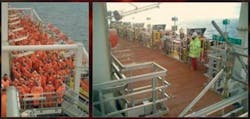Survey assesses geohazards for record subsea pipeline
James Nicholls
Flintshire Geoscience Ltd.
The Galsi pipeline across the Mediterranean Sea will transport natural gas from Algeria to Sardinia and mainland Italy once completed. Parts of the 560 km (348 mi) offshore route encounter difficult seabed morphology, descending and climbing steep slopes in water depths approaching 3,000 m (10,000 ft).
Variable and potentially unstable soil conditions exist on the route. Secure engineering design and stable pipeline routing call for detailed knowledge of seabed structure and topography, plus an insight into the geotechnical properties of the soils on the seafloor.
Galsi is an acronym from the Italian Gasdotto Algeria Sardegna Italia. The project company Galsi S.p.A. was incorporated in 2003 to promote and manage construction of the proposed new natural gas connection from North Africa into the Italian gas grid. Galsi’s shareholders are Sonatrach from Algeria, Edison and Enel from Italy, Italian utility Gruppo Hera, and Sfirs, the regional financial institution of Sardinia. Late in 2008, these partners were joined by Snam Rete Gas, Italy’s biggest natural gas distributor, which is to build, own, and operate the links to connect Italian customers to the energy supplies of the Galsi pipeline.
In 2007, Galsi commissioned Fugro to undertake a detailed marine route survey (DMS) comprising a series of investigations along the entire marine route – from the site of a proposed compression station near the Algerian coast to a beach landfall facility in the south of Sardinia, and from Olbia in the north of the island, across the Tyrrenhian Sea to Tuscany.
Optimum route alignment
The DMS findings were needed to facilitate detailed engineering design and to provide the basis for route engineering input to the construction tender process. The objective of the offshore, near shore, and landfall route surveys was to acquire data to support optimum route alignment and mechanical design of the proposed pipeline as well as to satisfy requirements during pipeline installation and throughout the design life of the system.
Continuous route coverage was required from the deepest water, through the surf zone and across the beach to the location of proposed onshore processing facilities. The reporting and charting requirements alone called for detailed planning, careful management of a huge range of data types, and a large program of geotechnical laboratory testing.
The DMS was split into packages, each with a pre-agreed timetable and a pre-defined sequence to allow route details and investigation requirements to be modified in light of earlier findings. Galsi wanted to refine the proposed pipeline route on a continuous basis as the survey progressed and as data was processed. Fugro assisted Galsi by providing full access to all data collected during the survey in order to assess site conditions, to perform onboard engineering evaluation, and to adjust the survey program as necessary.
The preliminary route found the deepest water between Algeria and Sardinia, where 20% of the route lies on the abyssal plain at depths of around 2,850 m (9,350 ft). Moreover, descents from continental shelf to deep water were steep and difficult, requiring careful route selection to ensure pipeline stability and security. The Sardinian continental slope sections on both the Algeria/Sardinia and Sardinia/Italy segments were problematic and required additional offshore reconnaissance surveys to determine optimal route alignments. These route sections involved variations in seabed level as great as 2,500 m (8,202 ft) over distances of 50 km (31 mi) – an average gradient of 5%, with steeper slopes over shorter segments.
The offshore hydrographic and geophysical surveys were completed first, giving priority to optimization surveys in the above areas, continuing with feasibility surveys in other more difficult areas identified during reconnaissance, and ending with a high-definition survey along the entire offshore section.
To complete the program in water depths greater than 90 m (375 ft), Fugro mobilized the Echo Surveyor AUV from the support vesselGeo Prospector. AUV technology mapped the route with high resolution previously available only in modest water depths. The AUV carried a high frequency multibeam echosounder, a sub-bottom profiler, and a high-resolution side-scan sonar for a full geohazard assessment to be performed along the deepwater sections of the route, particularly in areas with difficult seabed relief or evidence of soil instability.
For acquisition in depths less than 90 m (295 ft),Geo Prospector has a suite of hull-mounted and towed hydrographic and geophysical survey sensors delivering multibeam echosounder, side-scan sonar, and shallow sub-bottom profiler data, plus magnetometer data as required. Geo Prospector also undertook a seismic geohazard survey along sections of the route to a depth of approximately 1,000 m (3,280 ft) below the seabed to identify the sub-seabed structural geology for further geohazard analysis, and to locate and identify major fault zones and discontinuities that might impact pipeline integrity.
The final element in the program was a series of surveys to provide additional detail at points where the proposed Galsi route corridor crossed existing cables and other pipelines, and to investigate any obstructions found within the corridor during the high-definition route surveys.
These special surveys involved use of deepwater work-class ROVs, rated to 3,000 m (10,000 ft) operating depth, deployed from the Fugro ROV support vesselSkandi Inspector. Each cable or pipeline within the route corridor was tracked over the full corridor width using ROV-mounted video cameras and a cable tracking system. Measurements were made to confirm the orientation of the cable or line, its depth of burial, and the exact crossing co-ordinates.
Geotechnical investigations
Onboard assessment of the hydrographic and geophysical surveys enabled Galsi to define a preferred route for the pipeline over all but the near shore sections. The next stage involved detailed geotechnical investigation of the route center line using of coring, sampling, and in-situ tests. To fully evaluate pipe-burial options on the continental shelf and also soil stability conditions on the continental slope, the specification called for direct sampling using gravity, piston, or rock coring methods together with in-situ penetration tests made by peizo-cone (PCPT) and T-bar.
The long piston corer and PCPT/T-bar were the prime sampling and testing tools on the continental slope. Because of the nature of the soils, 15-20 m (49-66 ft) penetrations below seabed were required, even in the deepest water. These investigations called for some of the largest and heaviest seabed equipment in Fugro’s geotechnical inventory, including a SEACALF, wheel-drive, cone penetrometer test (CPT) frame generating 50 kN (11,240 pound force) of thrust and the STACOR piston corer with a 20 m (65 ft) core barrel. This hardware was deployed from the dynamically positioned geotechnical shipBucentaur. SEACALF incorporates a self-leveling mechanism for in-situ soil testing even on uneven seabed with slopes approaching 5°. The STACOR piston corer acquired undisturbed samples to assist identification and aging of geohazards detected by geophysical techniques in the initial phase of the DMS. These geohazard studies benefitted greatly from inclusion of data interpreted from 50 or more box cores also acquired along the route.
Geohazard profile reports.
Closer to shore, a second geotechnical vessel,Fugro Commander, deployed sampling and testing equipment suitable for water depths down to 200 m (656 ft). This included a vibro-coring system for recovering ”undisturbed” soil samples in sands and stiffer clays, as well as additional equipment for coring and in-situ tests.
At the landfalls, a coastal geotechnical jackup platform and shallow draft near shore survey vessels were mobilized to ensure a continuous dataset in the transition zone between offshore and onshore. Onshore, personnel using specialist equipment gathered geophysical and geotechnical data between the landfalls and compression station sites, away from the beach.
Once Galsi had determined an offshore approach to each landfall, Fugro mobilized an inshore survey vessel to conduct hydrographic and geophysical surveys in waters of less than 20 m (65 ft).
The objectives were similar to those for the deeper water surveys but emphasized data to support engineering design for potential shallow-water trenching needs and specific pipeline installation methods between the landfall and near shore areas. In shallow water, Fugro offered a marine seismic refraction system to complement data acquired by seismic reflection profiling.
To complete the picture, a self-elevating jackup platform was sent to each of the landfalls to complete a series of geotechnical boreholes to approximately 10 m (33 ft) below seabed. The ground investigation included drilling by cable percussion and/or rotary methods, borehole sampling/coring, and standard penetration tests for in-situ soil.
The survey and geotechnical field work took about nine months to complete, involved 830 days of site work, and, at various times, required more than 500 people on site and 14 separate survey spreads. Data integration and production of the detailed charts, reports, and geohazard assessments was completed for the most part by Fugro GeoConsulting in Great Yarmouth, UK.
Since this project concluded, Galsi has continued to work with the data, charts, and reports to finalize project engineering and to obtain approvals necessary to move forward. Galsi’s focus has been to select a route giving the most reliable installation and with the least impact to environment and infrastructure.
The deepwater geoscience data provided by Fugro enabled the project engineering team to evaluate seabed geological conditions and scenarios, and to model active and recently active processes. This established an understanding of potential impacts to the project engineering and enabled a thorough geohazard risk analysis. By critical review of the mapped and modeled features and careful selection of the pipeline route, the pipeline was confirmed to be in the most favorable alignment in relation to irregular or potentially unstable seabed.
This engineering evaluation commenced most importantly during the early part of the AUV survey when Galsi engineers were offshore with the Fugro geoscientists to develop and monitor initial geohazard interpretations and review route options for final approval onshore.
The field data and final interpretations provided by Fugro included detailed geological description and age dating of key soils. Using this information as a reference, a number of geohazard workshops were initiated by Galsi. These hands-on sessions let Fugro geoscientists discuss and debate interpretations, and Galsi engineering and geohazard consultants, including independent peer review specialists, to assimilate the results and assess their engineering significance.
Galsi has provided soils and geomorphology information at consistently high resolution, extending from the proposed onshore facilities throughout all offshore and deepwater route sections. Galsi engineers have finalized initial design parameters, risk assessments and intervention requirements, which will permit the detail design engineers, soon to be appointed, to confirm seabed characteristics and requirements for pipeline installation.
In addition to engineering design, the imaging of seabed features and detection of debris in all water depths, allowed the early consideration of potential environmental impact and screening for archaeological significance. This allowed the appropriate specialists studies to be performed by Galsi for the regulatory permitting process.
While Galsi continues through the authorization phase, the initial engineering work is complete, and a positive conclusion to the review of the Environmental Impact Assessment, by the Italian Ministry of the Environment is expected very soon. This will lead to a final authorization to build from the Ministry of Economic Development. At that point, the Galsi partners will be in a position to authorize a final investment decision and to start the construction phase.
Offshore Articles Archives
View Oil and Gas Articles on PennEnergy.com


